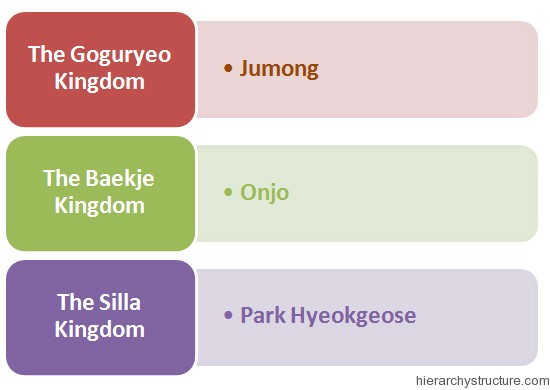There are mainly three kingdoms that were prevalent in Korea. The kingdoms are Goguryeo, Baekje and Silla. These three kingdoms are still the significant parts of the Korean royal hierarchy.
In this particular journal, we will discuss in details about the different kingdoms or dynasties and the about the rulers associated with the kingdoms. This will bring forward the arrangement of the Korean Royal Hierarchy in a systematic manner.

The Goguryeo Kingdom
Goguryeo was an ancient kingdom of Korea, covering mainly the northern and central parts of the Korean peninsula. A prince namely Jumong founded the Goguryeo dynasty in 37 BC. The kingdom was associated with the foreign affairs of the countries China and Japan. Jumong was the first king of Goguryeo.He was the son of Prince of Buyeo. Jumong was famous for his efficient archery skills.
There were a total of 28 rulers of the Goguryeo dynasty. After Jumong, Yuri became the second ruler, Daemusin the third, followed by Minjung, Mobon, Taejo, Chadae, Sindae, Gogukcheon, Sansang, Dongchen, Jungcheon, Seocheon, Bongsang, Micheon, Gogugwon, Sosurim, Gogugyang, Gwanggaeto The Great, Jangsu, Munjamyeong, Anjang, Anwon, Yangwon, Pyeongwon, Yeongyang, Yeongnyu and finally Bojang at the 28th position. This kingdom saw the rise and fall of the kings, one by one.
The Baekje Kingdom
The Baekje kingdom of the Korean royal hierarchy was located in the Southwest region of Korea. This kingdom was founded by Onjo, who was the third son of Goguryeo’s founder Jumong and So Seo-no. In the 4th century, Baekje expanded and took control of most of the parts of the western Korean peninsula.
The kingdom extended its territory up to Pyongyang in the north and even conquered certain areas of China. The Baekje kingdom also had significant political and economical relations with China and Japan at that time.
There were a total of 31 rulers of the Baekje dynasty namely Onjo, Daru, Giru, Gaeru, Chogo, Gusu, Saban, Goi, Chaekgye, Bunseo, Biryu, Gye, Geunchogo, Geun-gusu, Chimnyu, Jinsa, Asin, Jeonji, Gu-isin, Biyu, Gaero, Munju, Samgeun, Dongseong, Muryeong, Seong, Wideok, Hye, Beop, Mu and finally Uija at the 31st position. In 660, the kingdom was defeated by the union of Silla and the Tang dynasty of Ancient China.
The Silla Kingdom
Silla is one of the three kingdoms of Korea and is one of the longest sustained dynasties of the World. The Silla kingdom was founded by King Park Hyeokgeose. The king was also the originator of the Park Korean family.
Silla conquered the other two kingdoms namely Goguryeo and Baekje in 668 and 660 respectively and gave rise to Unified Silla, occupying most of the Korean peninsula. In the initial years, the Silla kingdom was ruled by the Pak, Kim and Seok families. The Unified Silla was ruled by 27 rulers from the period 661 to 935.
The Silla dynasty of the Korean royal hierarchy was the last kingdom and after the fall of Silla, the Europeans started invading the parts of Korea.
Know more about North Korea Political Hierarchy Click Here
